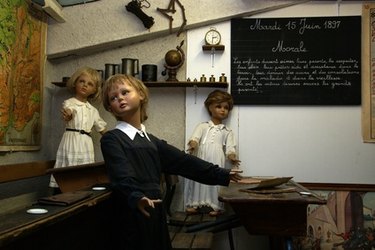Things You'll Need
Ventriloquist headstick
Head casting kit
Ventriloquist dummy hands
Ventriloquist dummy feet
Ventriloquist figure eyes
Ventriloquist dummy body
Paper mache
Wig
Glue
Self-hardening clay
1/4 inch dowel
Sliding door roller assembly B-551
Drill
1/16-inch brass tube
Screw Eyes
18-gauge copper wire
Muslin
Polyester fiber stuffing
Cotton batting

Ventriloquists can save money by assembling a dummy from parts. Building a ventriloquist figure also gives ventriloquists an original dummy to work with rather than a store-bought dummy. The process of putting a ventriloquist figure together can prove to be complicated and requires a large amount of focus and preparation. Anyone who feels strongly about ventriloquism should consider building a dummy. The process can be quite satisfying to an enthusiast, and the finished product will have more value than a store-bought dummy.
Head
Step 1
Sand down the head casting kit, being careful not to deform the figure. Clean off the particles from sanding.
Video of the Day
Step 2
Wrap paper mache around one end of the headstick until it fits snugly into the head. Ensure that the string holes remain exposed.
Step 3
Cement the brass tube from the head casting kit in the jaw using self-hardening clay. Twist a screw eye into the tab at the bottom of the jaw. The string that controls the jaw will run along this screw eye.
Step 4
Slide the door roller assembly onto a 3-inch section of the 1/4-inch dowel. Drill a 1/16-inch hole into the dowel on each side of the roller assembly. Wind the 18-gauge wire around each side the roller, looping the wire over the roller in the middle for the nylon cord to run through.
Step 5
Cement the dowel in the back of the head casting so that it aligns with the roller in the jaw when assembled. Tie the nylon cord to the screw eye and run it through the roller assembly and out the hole in the bottom of the head casting.
Step 6
Tie the other end of the cord to the jaw lever in the headstick. Cement the brass tube ends in the jaw to the inside of the head casting.
Step 7
Install the eye assembly by cementing the 1-inch- by-6-inch board from the kit above the jaw in the head casting. Ensure that all parts move freely before permanently bonding them to the head casting.
Body
Step 1
Sew two 12-inch-by-7 inch patches of muslin into tubes to make arms, and two 17-inch-by-9-inch patches for legs. Turn them inside out to put the seam on the inside. Fill them with polyester fiber stuffing and staple them to the body.
Step 2
Staple a shoulder piece made from the cotton batting over the joints connecting the arms to the body, covering the muslin with more batting.
Step 3
Paint the hands, feet and face the flesh tone of your choice.
Step 4
Twist 18-gauge wire around the muslin covering each of the hands and feet inside the arms and legs, aligning the wire with the indentations in each appendage. Fold the sleeves back over the wire.
Step 5
Comb, style and glue the wig to the head casting. A professional hairdresser may also style your wig. Insert the headstick into the body by fastening it to the base board with a rubber band.
Tip
To save money, substitute molded feet with an extra patch of stuffed muslin fabric. Put shoes on the feet to cover the fabric.
Warning
Take care when permanently setting parts with self-hardening clay and when styling the wig. The hair in the wig won’t ever grow back, of course.
Video of the Day